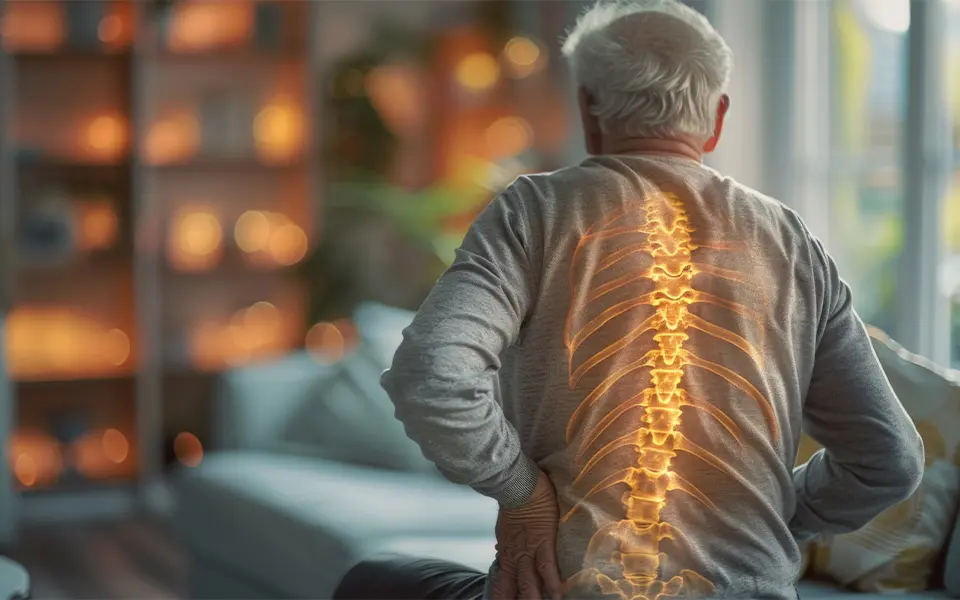July 15, 2024
Management of Chronic Pain in Older Adults
Chronic pain is a common issue among older adults. Studies estimate that between 25% and 85% of seniors experience persistent pain regularly. Chronic pain can negatively impact quality of life and lead to other problems like depression, trouble sleeping and reduced mobility. Effective and compassionate pain management strategies are important to improve the quality of life and well-being of older adults.

What is Chronic Pain?
Pain is considered chronic when it lasts three months or longer and beyond the normal healing time for an injury or illness. It can be constant or intermittent and can range from mild to severe.
Common Types of Chronic Pain in Older Adults
- Arthritis Pain: Aching, stiffness and swelling in the joints that worsen with activity due to the breakdown of joint cartilage over time.
- Back and Spinal Pain: Tenderness, numbness and pain radiating into the buttocks and legs caused by degenerative changes, narrowing of the spinal canal or weakening bones.
- Musculoskeletal Pain: Tenderness, weakness and localized or widespread discomfort from osteoarthritis, overuse injuries or referred pain from other health issues.
- Neuropathic Pain: Burning, shooting or tingling sensations often accompanied by numbness or sensitivity to touch, caused by diabetes, shingles, vitamin deficiencies, chemotherapy or nerve compression.
- Headaches and Migraines: Severe head pain with nausea, vision changes and sensitivity to light and sound, caused by headache disorders, stroke, unmanaged stress or medication side effects.
Consequences of Untreated Chronic Pain
Pain can have far-reaching effects on older adults’ health and well-being, impacting nearly every aspect of their lives. Lack of effective pain management often leads to a cascade of negative consequences, both physical and psychological.
Some of the most significant impacts of uncontrolled pain in seniors can include:
- Reduced Mobility: Uncontrolled pain can lead to activity avoidance, deconditioning and increased risk of falls and injuries, limiting independence.
- Sleep Disturbances and Fatigue: Chronic pain frequently disrupts sleep, which can exacerbate pain, decrease energy levels and impair daytime functioning.
- Depression, Anxiety and Social Isolation: Persistent pain is associated with mood disorders and can cause withdrawal from social activities and relationships.
- Cognitive Impairment and Increased Risk of Dementia: Studies show seniors with chronic pain have a higher likelihood of developing memory problems and dementia compared to those without pain.
- Decreased Quality of Life: Unrelieved pain significantly diminishes physical, psychological and social aspects of an older adult’s quality of life.
Benefits of Effective Pain Management
Proper assessment and treatment of chronic pain can greatly improve seniors’ health, functioning and overall quality of life. Some of the benefits of well-controlled pain in older adults include:
- Improved Physical Functioning and Mobility: Effective assessment and treatment of chronic pain can allow seniors to stay more active, participate in physical therapy and exercise and maintain their independence for longer.
- Enhanced Quality of Life: Adequate pain relief improves an older adult’s physical, psychological and social well-being, leading to greater overall life satisfaction.
- Reduced Risk of Depression, Anxiety, and Social Isolation: Effective pain treatment can help prevent the negative psychological impacts of chronic pain, improving mood and social engagement.
- Better Cognitive Function: Well-managed pain reduces the likelihood of delirium and long-term cognitive impairment.
- Decreased Healthcare Utilization and Costs: Optimized pain management can reduce the frequency of doctor visits, emergency room visits and hospitalizations, and lower overall healthcare expenses.
Ways to Effectively Managing Chronic Pain in Older Adults
- Take a Multidisciplinary Approach. Address physical, psychological and social aspects of pain with a combination of medication, physical therapy, counseling and other tailored modalities.
- Start Low and Go Slow with Medications: Begin with the lowest dose and titrate up slowly to minimize side effects. Regularly review medications to optimize pain relief and eliminate unnecessary drugs. Be cautious with NSAIDs and opioids.
- Include Non-Pharmacological Therapies: Incorporate exercise, physical therapy, heat and cold application, acupuncture, massage, relaxation techniques and cognitive behavioral therapy to reduce reliance on medications.
- Encourage physical activity. Regular exercise like walking, swimming, tai chi and gentle stretching can help maintain joint flexibility, muscle strength and physical function.
- Teach Self-Management Strategies: Educate on pain-coping skills such as deep breathing, meditation, distraction techniques and activity pacing.
- Regularly Reassess and Adjust the Pain Management Plan: Continuously monitor effectiveness and make adjustments as needed. Maintain open communication with the healthcare team and caregivers to optimize pain control and quality of life.
Conclusion
Effective management of chronic pain is important to improve the quality of life of older adults. A comprehensive approach combining medication, therapy, exercise and self-management strategies can help seniors better cope with persistent pain and maintain their independence.
Pain Management at Embassy Healthcare
We combine medical, physical and complementary therapies to help our residents manage pain and live the highest possible quality of life. To learn more about pain management at Embassy Healthcare, call 216-378-2050 or contact us online.
